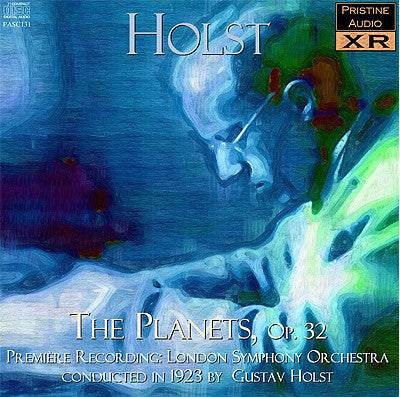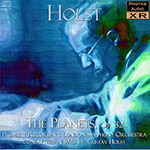
This album is included in the following sets:
This set contains the following albums:
- Producer's Note
- Full Track Listing
- Cover Art
- Additional Notes
One of the most amazing acoustic restorations you'll ever hear
Aaron Z. Snyder's incredible remastering of Holst's 1923 première recording
The acoustical recording of Holst
conducting The Planets might appear at first to be an unnecessary
restoration, since he recorded an electrical version only two years
after he completed recording the final movement (Saturn - they were
recorded non-sequentially). Yet, there are interpretive differences
between the two versions, most notably in Venus, which, in 1923, has a
duration of 8:04, but by 1926 it is down to 7:09. Some critics feel that
the earlier effort is a better interpretation, although that cannot
really be said about the central theme of Jupiter, which, in 1922,
begins too fast, rapidly slows down to a crawl at the end of the side,
and then resumes on the subsequent side at a more reasonable tempo. In
1926 the tempo remains proper and steady across the side break.
Irrespective of the interpretive worth of the acoustical version, for
the restorer this is an example of one of the best orchestral recordings
made before the adoption of the electrical method of sound recording.
For one thing, it appears that Holst has made few, if any, instrumental
substitutions (I cannot detect any). Therefore, a restoration can
potentially result in an orchestra which sounds normal, as compared with
orchestras which have, for example, tubas substituting for contrabassi.
No doubt the orchestra is smaller than usual due to the physical
limitations of an acoustical studio, in which everyone is trying to be
as close to the recording horn as possible. Regarding the horn itself,
it must have been a large one, because some sounds as low as 40 Hz are
faintly visible on a spectrographic representation of the recording. It
is also to be noted that the horn managed to capture some high overtones
going up to nearly 5 kHz (!). While much of the recorded sound rolls
off above 3 kHz, there are many overtones which can be seen, although
there are also inconsistencies in their presence or absence.
The major part of the restoration process is amplifying those weak
signals by building digital filters which will work on music content
only. A general bass boost won't work, since, aside from the fact that
the transfer function of the acoustical recording device can be only
approximated, any general boosting of a frequency region will boost
surface rumble along with the signal. The process used is almost 100%
manual, with visible signals being boosted, and using a known-good
recording as a visual reference as well as a score. In some cases low
fundamentals cannot be seen, and need to be coaxed out of the noise by
building a filter where that tone is expected to be. It's a painstaking
process, but fortunately, with experience, it requires much less time
than one might expect. The same process has been applied to some of
those upper frequencies, where the signals can be seen, but are too weak
to be audible. Once the process is finished, the overall equalization
is then balanced against a known-good recording using Har-Bal*. This in
itself requires some manual correction afterward, since the noise level
in various frequency ranges can increase to an unacceptable level.
Except for gross click removal, my noise reduction techniques were
mostly a manual process. Perhaps I'm a bit unconventional in this
regard, but I worry that automatic processes may undo some of what I
have spent so much time doing!
Since each planet, with the
exception of Mercury, requires only two 78-rpm sides, editing of the
sides together presented no real difficulties - with the exception of
Jupiter. As mentioned above, Holst slows down to a crawl at the very end
of the first side and distends the final note to an absurd length.
Digitally "splicing" the two sides together at the break point would
sound quite strange, at best, I ruled out using digital tempo regulation
to speed up the slowed-down version, since it would, in essence,
falsify Holst's performance, misguided as it was. I opted to shorten the
length of the final note from the first side and move one of the
audible beats very slightly, so that what we end up with is a slightly
exaggerated moment of rubato followed by a steady tempo. I think this is
the most musical way to edit these sides without falsifying the
performance.
Also, please note that I have enhanced the sound
of the cymbal wherever I have determined that Holst used one. It appears
(although I cannot prove it) that Holst omitted some of the cymbal
clashes from Jupiter and Uranus, although there appears to be no reason
for him to have done it. Once again, with the purpose of avoiding
falsification, I decided to leave these spots untouched.
Aaron Z. Snyder, restoration producer and engineer
N.B. We have listed this recording as an XR-remastered production as, in addition to his own specialist techniques outlined above, Aaron Z. Snyder brings to the overall sound of the recording a re-equalisation based on the principles behind Pristine Audio's remarkable XR remastering techniques, something he's also used on a number of highly acclaimed recordings available on CDs from Music & Arts.
HOLST The Planets Suite, Op. 32
with Women's Chorus
conducted by Gustav Holst
Recorded in Petty France Studios, London, 1922-3
Engineered & produced by Arthur Brooks
Issued as UK Columbia 78s: L.1528, 1499, 1543, 1459, 1532, 1509, 1542
Matrix nos. AX.197-8, 136-7, 135; 75204-5, AX.199-200, 138-9, 205-6
Restoration and remaserting produced by Aaron Z. Snyder, October 2008
Ambient Stereo processing (on non-mono issues only) by Andrew Rose
Cover artwork based on a photograph of Gustav Holst
Total duration: 43:36
Attempting to unravel Holst's recordings of this
work can be devilishly complicated, largely due to Columbia's practice
at the time of re-recording sides, movements, or indeed, the entire
recording, and reissuing it on discs with not only the same catalogue
number, but also the same matrix numbers.
Thus it was with great relief that I was able to mine the information held in the London Symphony Orchestra's mammoth 910-page online discography [as of 2008], to figure out exactly when and where these recordings were made - you'll find the acoustic and 1926 electric remakes listed between pages 193 and 199. Here we present the information relevant to this issue:
COLUMBIA
27 Oct 1922 - Petty France Studios
LSO, Gustav Holst
HOLST The Planets Op.32 H125
Jupiter 75204-5
78rpm: (Feb23) L1459; 67148D in set M29.
The
six other movements were recorded in Aug-Nov 23. This movement was
re-recorded on 15 Sep 25, using the same matrix and catalogue numbers.
COLUMBIA
Pr.& Eng: Arthur Brooks
[ab] 23, [c] 24 Aug, [de] 30 Oct & [f] 6 Nov 1923 - Petty France Studios
LSO, Gustav Holst, [f] women’s choir
HOLST The Planets Op.32 H125
[a] Mercury: AX135
[b] Venus: AX136-37
[c] Uranus: AX138-39
[d] Mars: AX197-98
[e] Saturn: AX199-00
[f] Neptune: AX205-6
Jupiter
had already been recorded in Oct 22. Saturn & Jupiter were re-made
in Feb & Sep 25, then the whole work was re-recorded electrically in
Jun-Oct 26, in all cases retaining the original catalogue numbers.
[a] Coupled with “Marching Song” on AX303, recorded on 14 Feb 24.
78rpm: [b] (Nov23) L1499, [c] (Dec23) L1509, [d] (Feb24) L1528,
[e] (Mar24) L1532, [f] (Apr24) L1542, [a] (May24) L1543;
[a-f] set M29 = 67145-47/49-51D.

